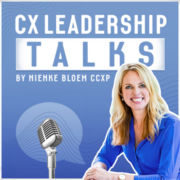Nine elements of successful CX Ambassador programs
The latest years I have seen many organizations that worked with CX Ambassadors. So many roles, and so many variations of domain of impact. For example, to implement customer improvements, or to be NPS ambassadors from all teams to make sure the metric and the thought behind it stays alive, or to build a culture of customer centric behavior, or to translate the brand values into daily work. As I have seen so many and some were a success and some just died a silent death (yes, that is a risk), I decided to deduct the nine elements of success.
1. Have common goals that link to the strategy of the organization
When people join an ambassador program, they want to understand how they contribute and what is the WHY of the program. It is the role from the CX team to give clarity on this element of belonging and contribution. Especially the strategy element is important, as people will be asked in their teams and their surroundings what their role as an ambassador is. Also make sure they can translate their work into the strategy and the goals of the Ambassador program. As a CX team you have to be able to answer the question, "When is our CX Ambassador program a success and how does it contribute to the success of the organization?" Because if you can't, your ambassadors most definitely can't either.
2. Make sure the ambassadors have time to act
It depends whether Ambassadors are chosen by management or whether they can volunteer to join your CX Ambassador program. One of the hurdles I often see is that of time. People get their ambassador role on top of their daily work. Especially when working in the frontline, with operational roles, you need to be aware that chances are they promise a lot but are more likely to be scheduled to be doing their regular job. I have seen programs where people got 20 percent of their time to work in the ambassador program; make sure this is planned in the WFM and help your ambassadors to own this new role. Enable them to have conversations with their team members and management. But also, you have to have conversations with the leadership, to emphasize the importance of the Ambassador program and the time people need.
3. Choose ambassadors wisely
Who should be the ambassadors? A very interesting question. Should they be picked by management, is that the modus operandi in your organization? Or could you have a kind of an audition program, where employees get to do interviews and really show why they are a good match? I hope you get to have a say in the selection process and have a diverse group of ambassadors. Especially at the start, make sure you get colleagues that have belief in Customer Experience, that have the right energy, that are curious and that are at crucial positions in the company. Later in time, you can choose to also engage the opponents. Especially when you have the first results in, this will convince them, and it gives you the authority that you can engage all. And of course, make the Ambassador team a diverse one, both on background, gender, roles and global footprint (when applicable).
4. Give guidance and build a system of support and clear governance.
Ambassadors need support to fulfill their role. Often their roles have an evangelist and activist element which has impact on the organizational status quo. This means they have to work on customer change and different behavior. That isn't easy, so help your ambassadors with the resistance they will encounter. Create FAQs with the most asked questions and answers they might give. Help them with tools and interventions so they can really act on their role. It is also important that you help them tell the story, especially when the evangelist element is fundamental. Practice the change story together. Give them customer stories, video clips, customer verbatims, that they can use in their change roles. I often see communities with a shared platform, where all resources can be found. Make sure you are the activator and stimulator of this platform.
5. Share and reward success
Some ambassadors hit the jackpot and some won't. It is very important to deep dive the elements that enhance success. What really works is to put the people in the spotlight that are nailing it. That are really creating customer impact, that raise metrics, that change the customer status quo. I have seen Awards for the CX Ambassador of the year, which is kind of formal. But I have also seen stories highlighted on the intranet and Yammer communities where CX heroes were celebrated. Make sure you put the spotlight on their success, but also on the journey toward success. Share the honest truth and give them the praise they deserve. And... if your ambassador program is a true success, give yourself the right platform and go for a CX award yourself or with the team. Whether at the Global Insights Exchange of the CXPA or the International CX Awards. This can give you the internal authority, praise of colleagues and often an internal leadership boost.
6. Get together in real life
This might be difficult in global programs, but it is of true importance that Ambassadors know each other. So they know their peers, so they can have conversations when stuck, or to build on capabilities. I often see Zoom calls, Skype meetings and yes, these are practical. But when you really want success, claim budget for real life get togethers. Enhance learning, networking and a real foundation of CX belief when you see each other. What I have also seen, is that when Ambassadors have to make a real effort to travel, they are even more connected to the program later. When you finish a person to person event, make sure you give the colleagues shiny certificates or other status symbols they can take to their offices. To show off and have a physical reminder of their ambassador status.
7. Involve leaders
Somehow, I have seen most CX Ambassador programs that only have team members from operational roles. Where are the leaders, where is the management? It can't be that they are too busy... So, when you start and choose the ambassador team, make sure you have the option to also pick leaders. If that is not the case, make sure you engage leaders in a different way. Communicate regularly about the Ambassador program and mention their teams when they deliver results. But also have conversations when the Ambassadors fall short and they indicate they don't get the time they need. These conversations might be tricky, but this is the only road to go. Especially when you feel some leaders don't support the program. If I can give you one most important suggestion it is: include the CEO. Make sure he/she expresses the importance, shows up in a real life meetup, or in a Zoom. That he/she asks questions in meetings how the participation of the Ambassador program is going.
8. Have 'who takes over' conversations and an on-boarding program
People will leave teams, get new roles, get sick or might even leave the company. To have continuity, you need to think of this at the beginning. Especially when people are selected and start: be honest and ask what will happen when they eventually are not there. For whatever reason. Do they have somebody that can replace them, do they have a next in line idea? It is a good conversation to have, since this also shows your sincerity and serious approach to the Ambassador program. When they stop, give them a fond farewell, a big thank you. Also give the new ambassadors a warm welcome. Make sure you have a welcome/onboarding procedure. That is crystal clear on expectations. That helps you and the ambassador to start of in the best way.
9. When the vibe is down, stop or show stamina and refresh
The good thing at the start of a CX Ambassador program is that everybody is fully energized. Starting new things just has a good vibe. The lights are all green, the program has power, maybe even an own logo. You have somebody who is responsible for the selection, communication and the meetups. And then ... after a year the vibe might be down. The participation is less. Other priorities might come up. What to do? This should already have been taken care of in the startup. To raise the 'what if questions' and the mitigating actions. But it will happen. This is the moment where you have two choices. Either you stop the program. With a real celebration of the success, a big thank you to all participants. Or this is the moment your endurance comes in. Where you show stamina. Continuity is key and you have to stick to the rhythm of communication. Make time in your calendar to prepare meetings, to tape videos, to share stories. And when the vibe is really down: refresh. Give the program a boost with a new logo. With a new story line, maybe even a new face of the CX team.
When to start an CX Ambassador program
Ambassador programs are just tha bomb. Yes, I am an enthusiast and I have seen some great examples where the organization was engaged by the success of the program. You don't start an Ambassador program when you just started the CX team. It is something to start when you have grown a little more mature. When the fundamentals are there: a CX team, a clear CX Strategy and of course the budget.
Your learnings
I am so curious for your learnings. I have two questions:
- What are fundamentals that you have encountered in your CX Ambassador program that really created success, that are your success factors?
- Please be in contact when you have a great Ambassador story. As I am writing the CX Travel Guide in English, I am looking for international stories and I would love to learn from yours and share your story.
So, please share your insights and comments and of course, feel free to like, love and share this post.
** Subscribe to her weekly CX Greetz. **
*****
Nienke Bloem is often called the Customer Experience speaker in the blue dress.
She's a global CX thought leader, educator and a global keynote speaker who inspires audiences with best practices and proven methodologies. She leads a speaking practice, a CX game company and a training business; she breathes Customer Experiences and is author of two CX books.
Her two-day Customer Experience Masterclass is known as the best program to prepare for your CCXP and she is the go-to person for CX leaders who want to advance their leadership and bring direct results from their Customer Experience transformation programs. Since 2020, she hosts a CX Leadership Masterminds program and helps leaders spice up their leadership and deliver an engaging CX Story including a solid CX Strategy. Besides, she is a modern-day pilgrim and found the parallel with leading customer centric transformations.
With her over 20 years of corporate experience, she speaks the business language. Her keynotes and education programs in Customer Experience are inspiring and hands-on. She is one of the few Recognized Training Partners of the CXPA and it is her mission to Make Customer Experience Work and help you deliver business results.









